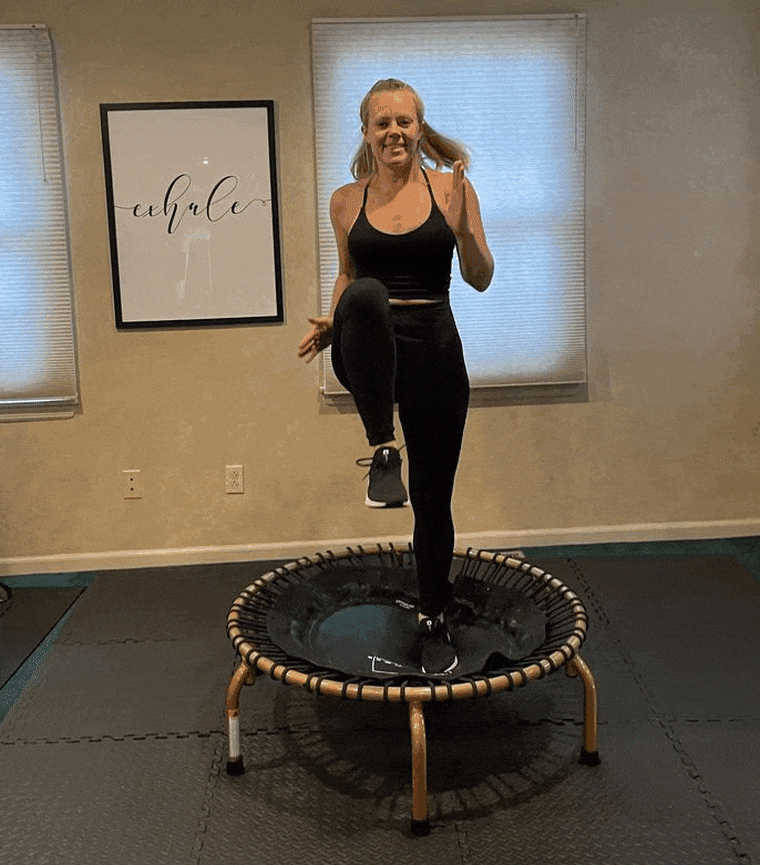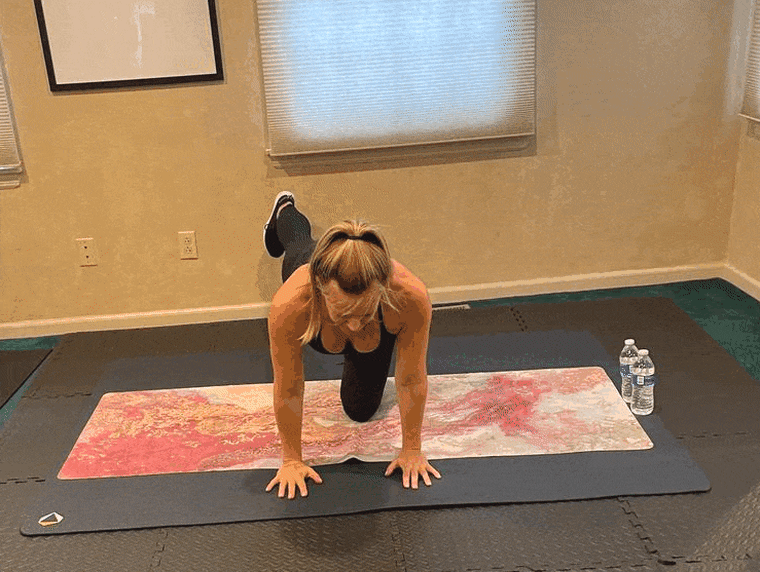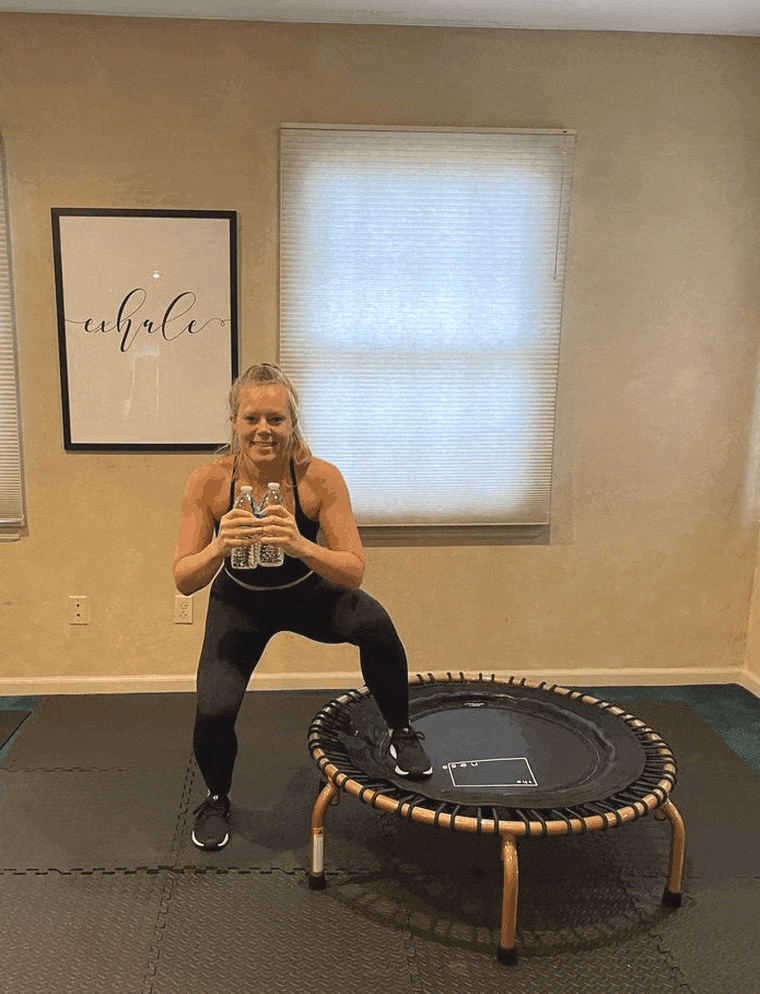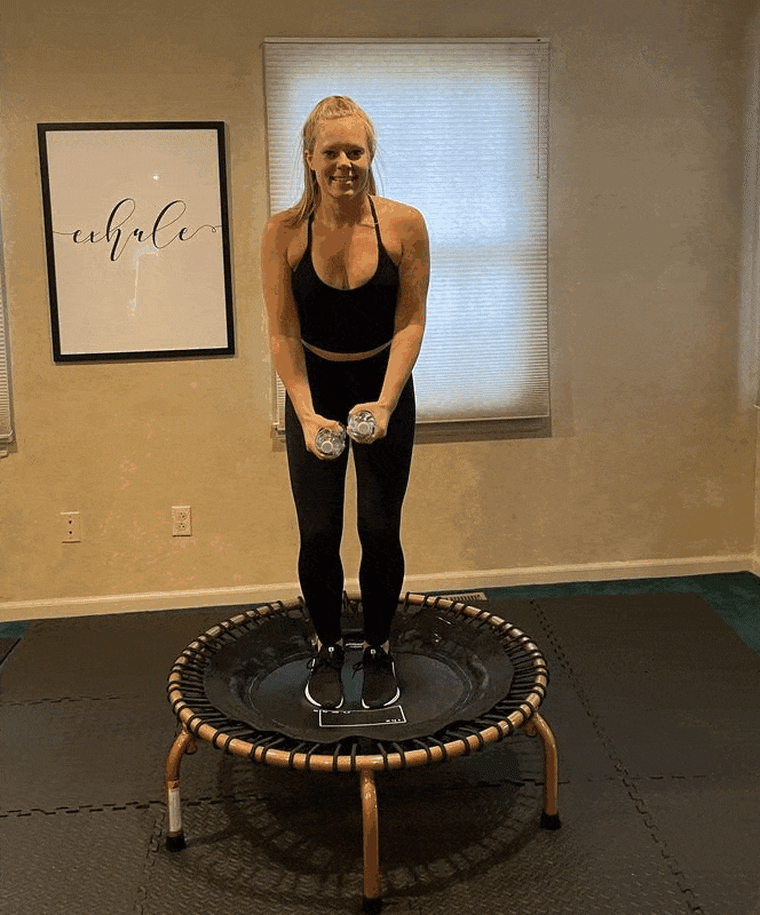I was introduced to rebounding — a cardio workout done on a minitrampoline — in my early 20s. My college roommate and I used to take a class at the gym twice a week with a man who would belt Broadway show tunes while leading us through challenging choreography and I loved it. We would forget about the stress over that paper due by midnight and lose ourselves in the bounce. To be honest, I had so much fun I would forget I was even exercising. I ended up dropping a few pounds and toning up without even really trying.
It’s been years since I took a class, but after the pandemic forced me to get creative with at-home workouts, I was curious whether the same fun (and results) could be had at home.
I stumbled upon The Ness, a trampoline cardio and sculpting studio with a digital platform you can access at home, who touts celebrity fans like Eva Longoria, Gwyneth Paltrow and Kelly Ripa. I liked that they had their own trampoline and that if I liked the classes at home, there would be an in-person option as well. And of course, the celebrity endorsements didn’t hurt. So I decided to dust off my rebounding skills and give it a try.
Cost and equipment
To access the on-demand classes, you will need a membership, which costs $39.99/month or $360/year.
The Ness trampoline costs $499, and comes with a complimentary three-month membership. It was easy to set up: All it required was screwing the legs onto the trampoline which took about five minutes. There are a few reasons that The Ness minitrampoline is worth a higher price tag. First off, it’s spring-less, using elastic cords for bounce instead, which makes it silent versus the creaking I was used to with the springs at the gym. It’s also great for in-home use: It’s aesthetically pleasing with a bronze frame and is much lighter than other trampolines, making it easy to move around. You can also adjust the firmness of the jumping mat, making it tighter or looser based on your bodyweight and desired bounce. That being said, if you are on a budget, there are much cheaper options on the market.
In addition to a minitrampoline, you will need a mat, gliders (or a towel) and a pair of light dumbbells (2-5 pounds) for the mat sculpt classes. I didn’t have light dumbbells, so I used water bottles instead.
The platform
The studio offers two main types of classes: bounce (done on the trampoline) and sculpt (done on a mat). The digital platform offers over 300 videos that range from 10- to 45-minute sessions, with new classes added every Monday.
Once you sign in, your home screen will display a suggested weekly plan of five workouts, a list of your saved workouts and additional programs available for purchase — as well as the ability to filter by workout length and to search for workouts in the library.
When you click into a workout video, you will see suggestions to level up or level down (by adding wrist weights or eliminating a bounce from certain moves), what equipment you will need, as well as a highlight of some of the moves you will do during the workout. People can also leave comments under each video on a message board and the instructors respond to questions or requests.
Every subscription comes with a complimentary 20-minute online consultation where the team will walk you through proper form, answer questions and help you choose your first few workouts. I skipped this since I was already familiar with the workout, but this is such a great feature since getting the hang of proper form when using a rebounder for the first time can be tricky.

The workout
First, I watched the short intro to get a refresher on the rebounder and some of the core moves.
After dusting off my rebounding knowledge, I started with the suggested weekly plan which consisted of five, 30-minute workouts. Up first was a 30-minute bounce. I had “intermediate” selected as my skill level, which I found out was too ambitious. I got five minutes in and knew I was in over my head. I guess it’s not quite like riding a bike. I bowed out and switched to a 30-minute bounce essentials class instead.
Bounce class
We started with a warmup off of the trampoline and then hopped back on for a round of squats. I instantly felt the added challenge of having to balance on an unstable surface. We then jumped right into some routines with jumping jacks, high knees and changing directions on the trampoline. This class was more my speed, but definitely not easy. After 10 minutes I felt my glutes fired up and contracting in a way I hadn’t felt in a while.
Bouncing on a trampoline is such a childlike movement; it doesn’t feel like you are torturing yourself with high knees (even though you are).
The bounce classes are beat-based and very much like dance cardio: You learn parts of a combination and then slowly piece them together until you run through the whole choreography by the end. As I’m not super coordinated and there were a lot of steps to remember, I found it challenging both physically and mentally. But the time flew by and I was able to master it by the end. I finished dripping sweat, out of breath and my hamstrings and glutes were on fire. It was really challenging, but I had so much fun. Bouncing on a trampoline is such a childlike movement; it doesn’t feel like you are torturing yourself with high knees (even though you are).
Mat sculpt class
The next day I decided to stick with the suggested intermediate class in my weekly plan — a mat sculpt class — since I am not a newbie to mat work like I am the trampoline. The 30-minute class used free weights (although there was the option to not use them) to target the arms, upper back and core. My legs were definitely feeling fatigued from the class the day prior, so I was happy to focus on the upper body and core.
The exercises felt really similar to barre or Pilates, with lots of repetitions using a light weight. I grabbed two water bottles because my dumbbells were too heavy and they worked just fine.

The entire class was done on the ground. The moves were really fast-paced and it was a little hard to keep up, but I definitely felt the burn. We started with an arm series and then moved into a series of modified planks broken up by child’s pose. I liked that after every set the instructor included a stretch to help the body recover a bit before moving on. We then did a leg pulse series, which added in a bit of oblique work. With one leg always off the ground, it definitely was a challenge to keep my balance, which kept my core engaged. Again, we moved really quickly through the movements and without some core strength as a foundation, it would have been very difficult to keep up.
The leg exercises hit that spot in the glute right where the butt meets the leg. This is an area I don’t often feel the burn when performing larger strength training movements like squats; I felt like I was getting deep into the muscle like I do with barre workouts. The class ended with abs. It really burned and got deep into the core. By the end, I definitely welcomed the long cool-down stretch.
The class was challenging, but it flew by. It took a lot of coordination, balance and mental focus. You never stay in one exercise for too long, so it was easy to push myself through the burn. It was really different then the typical strength training I do with heavier weights and larger, slower movements. Despite the burn, I was surprised how much I really enjoyed this class; it’s definitely one I would incorporate into my routine even without the bounce classes.
Bounce HIIT class
I felt energized after the mat work, so I decided to try the next class on my suggested schedule: bounce HIIT. This class felt like a combination of the original bounce class and the mat sculpt class. The class utilized the same light weights — or in my case, water bottles — and took place on and off the trampoline for a cardio workout that also incorporated some toning. The weights were really there to help get our heart rate up. We used them for most of the class, on and off the trampoline.
If I thought the sculpt class was fast-paced, this class was like pressing fast forward. The class alternated between high-intensity bounce combinations on the trampoline and bodyweight strength exercises off of it. It was designed to spike the heart rate and then lower it during active recovery work off the trampoline before spiking it again. My heart rate went through the roof — it was definitely a good HIIT workout.
Performing lower-body exercises like squats and lunges with one leg on the trampoline targeted my hamstrings and glutes in a different way and it burned out the muscles. The class also challenged my balance. During side kicks on the trampoline I had to stop and regain my composure because I felt myself getting out of control. You definitely need a foundation of proper bounce form to do this class safely. The combinations were fast paced and incorporated lots of different moves like kicks, side crunches and side-knee pulls.
The class finished with core work on the trampoline as an active recovery cool down. It was a little awkward to do crunches on the trampoline and my neck hurt by the end. I really needed a stretch and wish there was one included in the video, but we had used the entire 30 minutes working. At the end my legs felt like jelly and I felt like I got a full-body workout with an emphasis on the core, glute and hamstrings.

Since I was pretty sore the next day, I skipped the mat sculpt class on my schedule and did another 30-minute bounce instead. Again, I found it equal parts fun and challenging to master the combinations and I finished dripping sweat.
From these classes, my upper back, abs and glutes were sore for days. I felt a deep soreness in my upper abs that I haven’t felt from a workout in a long time. But it was the good kind of ache — the kind that proves you put in some serious work.
There is so much more for me to explore on the platform. I definitely plan on incorporating the sculpt classes into my routine once or twice a week. I loved how deep I was able to get into certain muscles and I think I would definitely see a difference in my body from this type of toning work. I also would like to work my way up to completing a 45-minute class — my legs are burning just thinking about it.
What I liked
This workout is just plain fun. There’s no other way to put it. The classes made me feel like I was back in a boutique fitness studio. It’s just so different than any standard at-home workout. It also takes so much mental focus that it makes you forget about your to-do list and forces you to be present.
I liked that the platform offers a suggested weekly workout plan, which takes the guesswork out of selecting a class and saves you time searching the platform.
The playlists are awesome. Seriously, a few times it was the music that kept me pushing through some serious burn when my body wanted to give up.
The workout is low-impact, but high-intensity, and I loved that I could get my heart rate up with a HIIT workout without putting any stress on my joints. My knees sometimes bother me during traditional HIIT classes and they never once bothered me in these classes despite all the jumping I did.
The classes are not only a physical challenge, but it’s mentally challenging to master some of the complex sequences. In this way, it was similar to dance cardio for me. It took a lot of mental focus to master the combinations, which also made the time go by faster and it felt like such an accomplishment when I finally nailed one. It was one of those workouts that left me feeling that “high” when I hopped off the trampoline. The workout is also addicting. I found myself actually wanting to exercise — the more comfortable I got on the trampoline, the more I wanted to nail more combinations.

What I didn’t like
My biggest complaint is navigating the platform. I was unable to figure out how to change my setting to beginner, and set on intermediate a lot of the classes were too difficult. Someone with no experience jumping could get really hurt trying to start with this level class. That being said, there are a ton of fundamental classes (which I found by searching “beginner”), so the content is definitely there to help you ease into it and teach you proper form, it’s just a matter of finding it.
The cost is also a barrier to entry: The Ness trampoline is a solid chunk of change, and the monthly cost is on the higher end compared to some other digital subscriptions I have tried.
It’s also a very specific type of exercise, so if you don’t enjoy it, it’s going to get old fast. The sculpt mat classes do break up the bouncing, but if you’re someone who likes lots of diverse options on their workout schedule, you’ll have to supplement with workout options outside of The Ness platform.
After bouncing for a few days, I had pain in my shins, calves and bottom of my feet, which is where I feel pain when running, too. It would be nice if the platform offered some deeper stretch classes that focused on the areas that take a beating when jumping. Even just five minutes at the end of the bounce classes would be appreciated! Doing the bounce classes consecutively for multiple day was too much on my body (which is likely why the suggested schedule breaks it up with the sculpt classes), so if you want to get more cardio sessions into your workout routine, you will need to have some alternate activities to do a few times a week.
I would recommend this workout to:
- Anyone who is a fan of dance cardio.
- Those looking for high-intensity, but low-impact exercise options.
- People who are bored with their routine and looking for some novelty.
- Those working out in a confined space.


